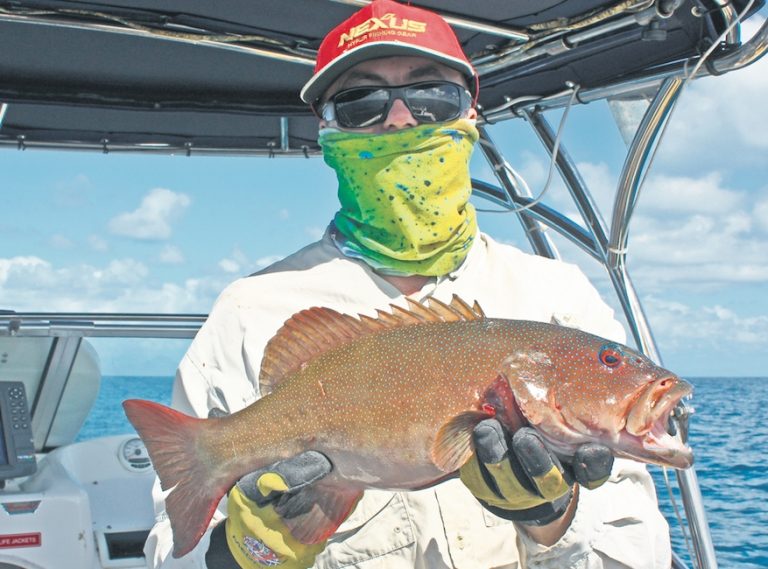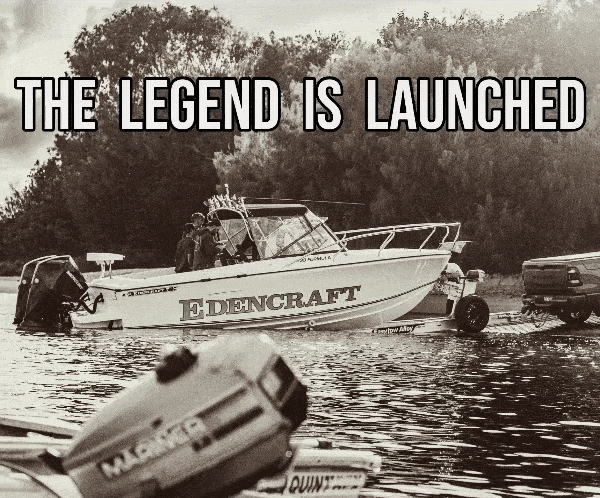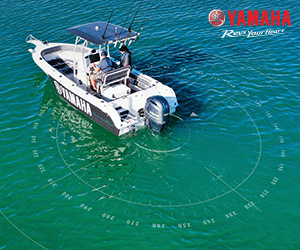Long weekend luring – Dan Bowater 2013
For many reef fishing enthusiasts the recent four day long Easter weekend was earmarked as a prime opportunity to spend some quality time on the water. In the lead up, predictions of a generous window of good weather culminating with the public holiday weekend were improving to a point where it would have been a crime to leave a boat in the garage.
Being aware of this situation, it was no surprise that one of my old mates from Cairns, Steve Polzin, was dusting off his popper fishing tackle for an all-out assault on one of his favourite reefs. His six metre Cruisecraft is a perfect boat for this purpose, featuring a huge rear deck area for comfortable fishing and shielded front cabin in case of an afternoon sea breeze. Combined with a 175hp Optimax it is the perfect tool for exploring new ground and wide reefs. It didn’t take much convincing for me to accept his invitation to spend a day focusing on the fish-rich fringes of Sudbury Reef area just south of Cairns. We call it ‘reef therapy’. Some scouting would be required to locate those sections suitable for casting poppers, but that’s half the fun of being out there! My local tackle shop on the Innisfail Esplanade was admirably doing the nightmare shift (working a weekend with perfect weather forecast) so I was luckily able to secure some last minute gear before hitting the road to Cairns.
Hammering out through the Trinity Inlet leads we eventually broke away southward towards Fitzroy Island, in doing so passing a series of mouth-watering rocky headlands at Cape Grafton and Kings Point. The contrast between the surrounding oceanic water and mountainous rainforest was an inspiring beginning enhanced by the first rays of piercing daylight. Horizon bound we sighted some distracting schools of longtail tuna that were too tempting to drive past. Considering we had both made recent upgrades to our spin sticks, it took only minutes before the first tuna hook-ups. Steve was using a classy Gary Howard G Force and I had my T-Curve ‘King Mack Spin’ rigged at the ready. Combined with some 50 gram slugs, these outfits mercilessly shut down the steaming runs of these longtail tuna. The small schooling longtails were easy pickings, and in normal circumstances would be put aside as fresh bait for bottom bashing. Not this time! On our day the boat was loaded with bundles of G.T poppers and Shimano Stellas so following that opening ritual just didn’t feel right. We landed (and released) a baker’s dozen then began our proper, more exciting, foray into the shallower edges… popper rods in hand! Truth be told, I actually sold my heaviest popping rod last year due to travelling restrictions (it was no use in the outback) and was relying on the lighter T-Curve to get me home. In its favour, the new rod still had the all-important enlarged fore grip that is crucial for pumping out double-handed casts with large lures.
Let the popping begin
Despite jovial predictions, the first half an hour failed to inspire us with only a few pesky longtom chasing our lures. We have learnt from past trips that it can be an uphill battle if you lose faith and constantly alter technique or location. Slowly but surely we began sighting all manner of fish holding on some of the better defined edges. First it was big-eye trevally stationed in a marauding school between two large bommies. Working a Roosta popper amongst them resulted in the capture of a morale boosting big-eye shortly followed by a good coral trout for Steve. It was incredible how several species favoured distinct zones, particularly those with parallel deep sections rather than a slowly tapering bottom. Logically, it makes sense, as predatory fish can move between the shallow bait holding reef and the sanctuary of deep water with ease.
Throughout the following half hour we continued casting more eagerly, having worked out a practical drift pattern with the big Cruisecraft. Steve had perfected our positioning so we were basically now taking pot shots at the more attractive bombies. On some casts we had up to three different species emerging from the reef shadowing our hapless poppers. This was what we were after! Remarkably there was little or no uniformity to what would emerge. Some casts would see a coral trout or cod, others it would be Spanish mackerel, queenfish or trevally. We were actually able to hook some very respectable Spaniards, but the locked up drag on our big spin reels offered a pretty low conversion rate. In past F&B articles Dave Magner has described the benefits of fishing light line classes for Spaniards. Heavy resistance can actually tear the entire bottom jaw off their skull when they do their trademark “shake n’ run” routine. While this mutilation didn’t actually happen on our trip, the heavy gauge owner treble hooks did the next worst thing, by simply tearing out each time. It was heartbreaking in some cases to see fifteen kilogram plus Spaniards annihilate our lures only to be lost in the same (all too) predictable way only seconds later. From six fish we only converted a lone nine kilo specimen that would at least give us a hearty return of tasty ‘mack’ steaks.
The giant strikes
The benefits of fishing heavy drag were, however, confirmed once we entered the next section of reef. Another school of big-eyes was milling on the surface prompting both our lures to be madly thrown in their general direction. Popping these lures through the school created the usual havoc, but what happened next caught us both by surprise. From the foaming water an enormous giant trevally simply charged straight through the centre of the uncoordinated attacks from the big-eye school. Unlike the other trevally, the GT made no mistake in engulfing my Roosta popper in one fell swoop. Steve had been in this situation many times. He instinctively powered into slightly deeper water as 40lb braid departed my locked up 4500 Saltist reel at a concerning rate of knots. Through the water we could see the braided line barely clearing the shallow reef ahead – it was literally centimetres from touching! Thankfully, the trevally changed its path into a small trench around fifteen metres deep where I was able to lean back and hold its rampaging runs with marginally better control. The large deck space in the Cruisecraft allowed me some decent footing to utilise the powerful low ‘fighting’ portion of my T-Curve rod. The combination of Steve’s experience on the reef and my desperate fighting technique had put us in a good position to land this bulky reef assassin. When the car door sized G.T surfaced beside us I nearly had a heart attack.
Steve immediately clasped both hands around its chunky tail scutes using a heavy duty set of gloves. He then unceremoniously dumped the beaten trevor straight into the centre of the rear deck. Neither of us could believe how we were able to stop it in unforgiving terrain and relatively light popping tackle. We both immediately yelled (something like), “Look at the impressive size of that large fish!”
The problem now was that I had to lift this big lure-demolishing lump off the deck for an obligatory photograph. My arms were jelly from the white-knuckled fight, so the biggest fight was in effect left to last. The best I could accomplish was hopelessly collapsing against the side of the boat like some rum-filled gambling pundit. In the end we had to improvise by cradling it in a seated position. Being widely regarded as a catch and release target, we had no real interest in weighing the fish. It’s very easy to start rattling off numbers like an auctioneer when estimating the weight of these bruisers. Instead I grabbed out one of my old brag mats from the cabin along with a handful of half-melted celebratory Easter eggs. At 104cm fork length it would be ‘somewhere’ in the vicinity of 40lb.
Why pop?
The next bommies were not quite as exciting but persistent casting eventually saw a few more tasty coral trout and sweetlip added to our mackerel ice slurry. Considering that we were using a very specific technique, it was eyebrow-raising to note the diversity of species occupying this shallow reef under five metres deep. We even saw a massive school of 100+ six to ten kilo milkfish uninhibitedly feeding on an algal slick (enough to make any fly angler fall to their knees). Many reef anglers argue that popper fishing cannot be compared to bottom bashing due the fact it requires a greater level of effort for a lower number of fish. In a sense, I agree with this observation, but it is not all about quantity. None of the fish we caught from the shallow reef were under minimum size and all were a handful (and a half) on popping gear. Apart from that, deep-water bottom-bashing does not include the same visual element that is so addictive when surface popping. Seeing large fish emerging from their coral lairs or intercepting your lure at pace really sticks in your mind for days. Furthermore, late in the trip we were actually sight casting to coral trout through one angler teasing them up with a popper and the other lobbing a deep diving minnow directly to them! In my view that is far more enjoyable than dragging up an unknown weight from the deep. Surface luring in shallow water also allows the angler to experience the magnificent colours and features of the reef more so than when vaguely seeing it from a distance.
During the trip home it was in the back of our minds (while scoffing down a few more partially melted Easter eggs) that perhaps the other bottom bashing boats may have out-fished us by focusing on deeper water. However, it was apparent this outcome never eventuated with every familiar boat at the ramp coming up empty handed by following traditional methods. On a side note, it is fantastic that a new work arrangement has allowed me to return to Far North Queensland after two years travelling through the outback and southern parts of the state. To be fair, I really did enjoy seeing some different locations during that time, but my trip with Steve highlighted why living in FNQ is so special. Unlike the other parts of Queensland, the reef is within easy reach of most boats in places like Cairns and Innisfail. The range of fishing options is vast and the kind of fish seen in dreams become sights on the end of your line during long weekends.
And a bit more on tackle selection…
Both Steve and I were more than impressed with the performance of our new spin outfits. In the past I had only used ‘genuine’ fifty pound GT tackle when attempting shallow water reef popping. The problem with this ‘status quo’ popping equipment is that it is simply so bloody tiring to use over the course of a full day. The tropical north is never an easy environment to spend hours repeatedly throwing lures that are almost as heavy as a can of baked beans. It can’t be denied that this factor discourages many regular reef enthusiasts from participating. I found that I was able to get away with using the T-Curve spin rod rated at a measly 8-12kg by upgrading my leader at the last minute to 80lbs. That was surprisingly easy to achieve as I simply tied a ‘uni to uni’ connection between an original rod length of 60lb leader and the ‘business end’ half metre length of heavier leader. I believe the final length of leader assisted casts and helped the popper track straighter than it would have by running only the original length. Obviously it also doesn’t hurt having the heavier leader when it is possible to hook fish over 40lb in weight!
The other advantage I found was by downgrading the braid main line at home from 50lb to 40lb Power Pro. The marginally lighter class of braid was far easier to cast. It could cast the poppers an extra five metres which occasionally allowed me to cover an extra bommie. At the same time it was still incredibly strong as outlined in the GT fight where around ten stern kilos of drag was dished out against one of the toughest opponents on the reef. In days gone by I would have persevered with a much heavier system that would leave my arms killing for days. With this potent lightweight popping approach it really makes the session much less of a chore. So next time there is a good weekend weather forecast remember to prepare wisely and enjoy the tasty fruits of this generally unpopular popping caper…





